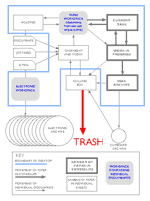Merlin’s weekly podcast with Dan Benjamin. We talk about creativity, independence, and making things you love.
Impressive paper-based project management workflow
Merlin Mann | May 27 2005
I like so much about the paper-based system Martin Ternouth describes (and illustrates!) in this Tufte thread that started in 2002 (scroll down a quarter of the way; sorry, no permalink). This system relies on several of the patterns that first attracted me to Getting Things Done— especially use of things like the “Overnight and Today” box which is like the Inbox in GTD, or like the many reviews that Martin builds into his process. There are a couple things in particular about this system that really resonate with me, and that, in my opinion, make this a must-read for people who either juggle multiple projects or have a challenging time managing their time and their workflow:
These are both things that I’d like to get much better at. Working at home, I have a habit of half-assing through the working hours of the day, and then half-assing through the supposedly relaxed family time of the evening. Neither one gets the attention it deserves as I blithely flip through emails or surf the web. So I find the idea of an “end of day” ritual intriguing. The practices Martin discusses, while probably a bit stiff for most excitable multi-taskers, represent the sort of “back on the wagon” strategies we all need when things start to get frayed. It’s also full of smart advice on the piece of GTD that most people still find most vexing: the implementation and maintenance of a trusted system. Lots of good stuff to consider adapting here—for GTD and beyond. For, you know, actual work. If you enjoyed Getting Things Done and like things like Josh DiMauro’s index card system, I really recommend you check this out. Thanks to Griff for the link tip. (See also: Malcolm Gladwell’s 2002 review of The Myth of the Paperless Office that led to this referenced thread. Like so much of his stuff, it’s a terrific read. Pick quote: “The solution to our paper problem, they write, is not to use less paper but to keep less paper.”) 18 Comments
POSTED IN:
 The full-text New Yorker article...Submitted by C.M. Biddulph (not verified) on May 30, 2005 - 9:00am.
The full-text New Yorker article "The Social Life of Paper" is available via LexisNexis Academic online database service. Check with local public or college library for access. » POSTED IN:
|
|
| EXPLORE 43Folders | THE GOOD STUFF |

